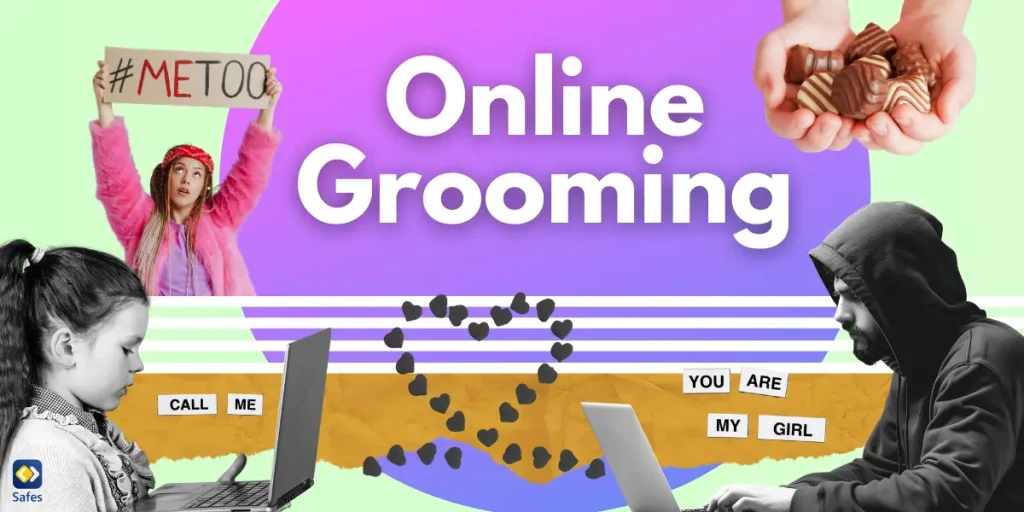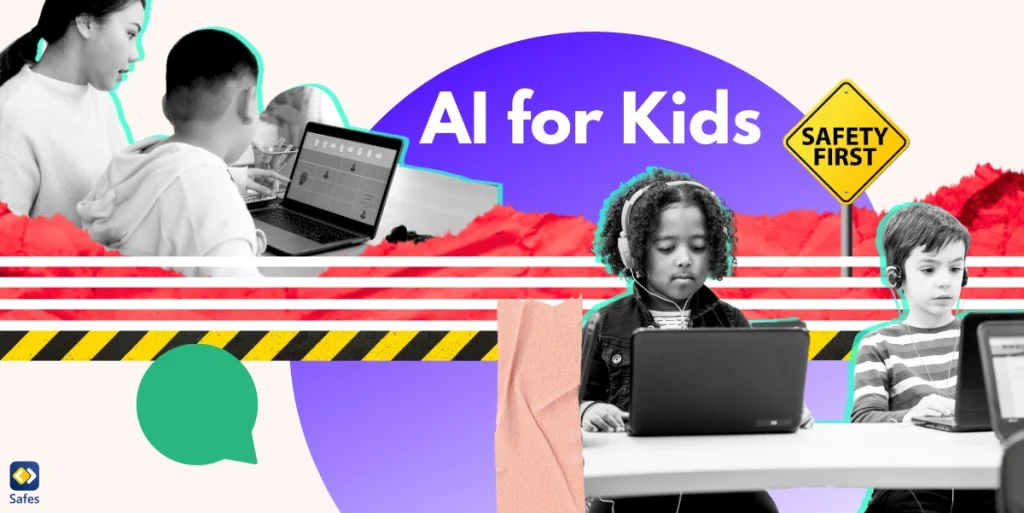Online grooming is considered one of the dangers in the cyber world, where adults try to build a relationship with kids to manipulate or harm them. It’s different from flirting and has potentially negative effects on the youth. As a parent, it’s important to understand how this works to keep your children safe. In this guide, we’ll look at the most common online grooming tactics and how you can protect your kids from them.
Download and Start Your Free Trial of the Safes Parental Control App
What Is Online Grooming?
Online grooming is when someone uses the internet to build a friendship with a child or teenager to take advantage of them. This person might start by being friendly and giving compliments. Over time, they try to gain the child’s trust and convince them to share personal information or do things they shouldn’t. The goal is often to manipulate or harm the child. It’s important for parents to know how this works so they can help keep their kids safe online.
How Is Online Grooming Different from Flirting?
Grooming involves an adult trying to gain a child’s trust to exploit or harm them, often by building a long-term, manipulative relationship. In contrast, flirting is usually about expressing romantic interest between people of similar ages and power without the intent to exploit. While grooming seeks to control and manipulate, flirting is typically about showing attraction or interest. Recognizing these differences is important for protecting children from potential online dangers.
What Are the Common Online Grooming Tactics?
As a parent, you need to be aware of the tactics adults use to gain your child’s trust to abuse them in different ways. There are some common ways to do it, knowing which helps you educate your child and help them be cautious about these behaviors.
1- Gaining Your Child’s Trust
Groomers start by being very friendly and showing genuine interest in the child’s life. They want the child to feel like they have a new, caring friend. For example, a groomer might start talking to a child about their favorite hobbies, such as sports or games, and show lots of interest in what they say. This friendly behavior helps the groomer gain the child’s trust, making them more likely to open up and share personal details.
2- Giving Compliments and Attention
Using flattery to make the child feel good about themselves is another online grooming example. They give lots of compliments and praise to build the child’s self-esteem. For instance, a groomer might tell a young girl that she is the smartest person they have ever met or that she has a beautiful smile. This kind of attention makes the child feel special and valued, which can make them more willing to continue the conversation and share more about themselves.
3- Sharing Secrets
When they share personal stories or secrets, they want to create a sense of closeness and make the child feel like they are part of a special relationship. They may share their own difficult experiences and ask the child to keep their chats private. This can make the child feel like they are part of an exclusive, trusting relationship, which can encourage them to share their own secrets or personal information.
4- Gradual Relationship Building
An online predator doesn’t rush into making a relationship with a child. They prefer a gradual process to make sure they appear as a trustful person. They may begin by talking about everyday things and then slowly ask more intimate questions.
5- Manipulation and Control
Children and teenagers are not mature enough to distinguish between good and bad and determine if an action is safe or harmful. Knowing this, groomers use emotional manipulation to get the child to do things they wouldn’t normally do. They might use guilt, threats, or promises to control the child’s actions. They may use different sentences, like “If you really cared about me, you would send me a photo” or other similar manipulations. This kind of pressure can make the child feel like they have to comply to keep the groomer happy or to avoid conflict.

What Is Groomers’ Goal?
It’s easier to gain control over a child and teen to make them different things. That’s why the young generation often falls victim to online grooming. Based on an article in 2024 about online grooming statistics and its lasting impacts, groomers’ goals can include:
- Forming a close social connection with the child to manipulate their behavior.
- Exploiting the child’s need for attention or validation to create dependency.
- Using fantasy or roleplay to blur boundaries and encourage inappropriate behavior
- Share and distribute indecent images of children, which is a form of sexual abuse.
- Use children’s trust for their own benefit or illegal activities.
Groomers carefully build trust over time to control and exploit the child.
What Are the Effects of Online Grooming?
Now that you’re familiar with the concept, you understand how dangerous online grooming can be. Affected children will deal with various consequences that can impact their future life. Here are some of the most important negative effects.
- Emotional harm: Children may feel confused, scared, or ashamed. They might struggle with trust and self-esteem issues.
- Mental health issues: Victims can experience anxiety, depression, and other mental health problems as a result of the abuse.
- Behavioral changes: Your child may act out, become withdrawn, or have trouble with their relationships. Also, the negative effects of online grooming on school performance are undeniable.
- Privacy violations: Sharing personal information or photos can lead to further exploitation or bullying.
- Trauma: The experience can leave lasting emotional and psychological scars, affecting the child’s well-being for years.
If you see any of these signs of online grooming, you need to meddle in right away and stop it.
How to Prevent Online Grooming?
To make sure your beloved child is away from being groomed online, we have some tips for you. First and foremost, you need a tool to monitor your child’s online activities and interactions. Safes, our parental control app, helps you see and control how your child uses their phone. Safes provides the necessary tools to manage your child’s online interactions, set privacy controls, and ensure they are engaging in safe and healthy online habits. This way, once an online groomer reaches out to your child, you’ll notice it and stop the interaction without your child knowing it about. Here are other tips for you.
- Teach your child about signs of emotional manipulation and the consequences of sharing personal information with strangers.
- Ensure that your child’s social media accounts and online profiles have strong privacy settings to limit who can see their information.
- Once in a while, review online safety tips with them.
- Regularly check your child’s online interactions and the sites they visit to stay aware of their online activity.
- Help your child recognize and question suspicious behavior or messages from people they don’t know and avoid online predators.
- Meet or get to know your child’s online friends, especially if they are interacting frequently.
With Safes, you can do all these protective measures. The tool works similarly to Windows parental controls but offers more access to features you need for controlling your child’s online activities.

Final Note
Online grooming is a serious threat that can have lasting effects on children and their well-being. By explaining this concept and sharing online grooming stories with you, we aim to educate parents about online dangers and their consequences. This way, we can help together to make a safe and healthy online environment for our vulnerable children.
Please don’t hesitate to download Safes for both Android and iOS devices and start your free trial to experience the benefits of a safer online environment for your child.
Your Child’s Online Safety Starts Here
Every parent today needs a solution to manage screen time and keep their child safe online.
Without the right tools, digital risks and excessive screen time can impact children's well-being. Safes helps parents set healthy boundaries, monitor activity, and protect kids from online dangers—all with an easy-to-use app.
Take control of your child’s digital world. Learn more about Safes or download the app to start your free trial today!




